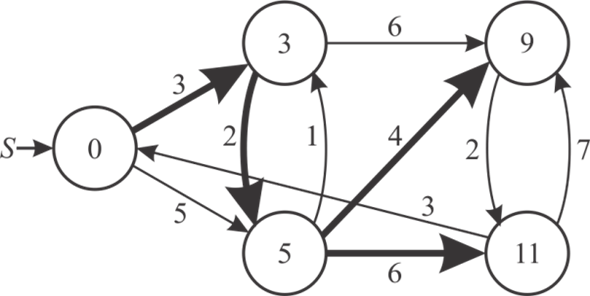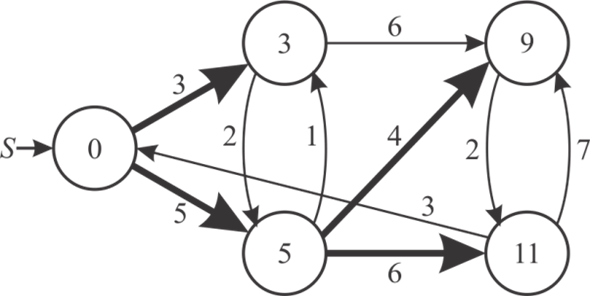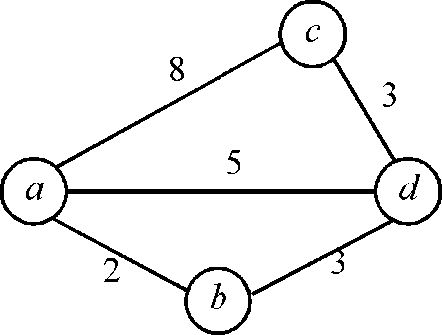Consider the following directed graph of Figure 24.2 provided in the text book to find the two shortest-path tree.
• Shortest path in any directed graph is not unique and it is possible to have more than one shortest-path tree with same source.
• Shortest path of any vertex v is updated only when shortest path is discovered.
The following is the Figure 1 with first possible shortest-path tree:

The following is the Figure 2 with second possible shortest-path tree:

• In Figure-1 and Figure-2 the dark line indicates the shortest path between all nodes.
• All vertices have the minimum weight between one node to another node.
• A shortest path from root s is directed sub graph
 where
where  is the
subset of vertex
is the
subset of vertex  and
and
 is
the subset of edge
is
the subset of edge .
.
•  is the set
of vertices that is reachable from source s.
is the set
of vertices that is reachable from source s.
• For all vertexes , the unique
simple path from source to vertex
, the unique
simple path from source to vertex  in graph is
shortest path from source to destination.
in graph is
shortest path from source to destination.
A weighted directed graph  with weight
function is
with weight
function is  and source
vertex s satisfy the property: for each edge
and source
vertex s satisfy the property: for each edge , there is a
shortest path tree from the source s which contains edge
(u, v) and there exists more than one shortest path tree
with source vertex as s which do not contain (u, v)
in its path.
, there is a
shortest path tree from the source s which contains edge
(u, v) and there exists more than one shortest path tree
with source vertex as s which do not contain (u, v)
in its path.
Graph  is the
collection of vertices V and edges E or it is the
pictorial representation of related data in the form of vertices
and edges.
is the
collection of vertices V and edges E or it is the
pictorial representation of related data in the form of vertices
and edges.
Graphs are of two types directed graphs that are the graphs in which edges are represented with arrow from one vertex to other and undirected graphs in which no direction is given.
The property “for each edge , there is a
shortest path tree from the source s which contains edge
(u, v) and there exists more than one shortest path tree
with source vertex as s which do not contain (u, v)
in its path” cannot be true for acyclic graphs since acyclic graphs
have unique edges.
, there is a
shortest path tree from the source s which contains edge
(u, v) and there exists more than one shortest path tree
with source vertex as s which do not contain (u, v)
in its path” cannot be true for acyclic graphs since acyclic graphs
have unique edges.
Consider the cyclic graphs:

Example:
Consider the edge  to find the
path from vertex a to vertex c paths in the graph
to find the
path from vertex a to vertex c paths in the graph
 would be
would be 
And without edge  the path can
be
the path can
be .
.
Both the path  and
and
 are
of same weight ((2+3+3) = 8) so both are shortest paths from vertex
a to vertex c first contains edge
are
of same weight ((2+3+3) = 8) so both are shortest paths from vertex
a to vertex c first contains edge  but the
second does not contains edge
but the
second does not contains edge  hence it
preserves the property.
hence it
preserves the property.
Let u be the vertex such that  is set to a
non-NIL value. Then, it is necessary to have s.d>u.d +
w(u,s).
is set to a
non-NIL value. Then, it is necessary to have s.d>u.d +
w(u,s).
Apply INITIALIZE-SINGLE-SOURCE (G, s) for the vertex s such that
the initial distance d[s] = 0 and the distance to the other
vertices that is v is infinite, d[v] =  and
and
 =
NIL.
=
NIL.
Only if the edge (u, s) is relaxed, then only  is set to
non-NILL value.
is set to
non-NILL value.
Suppose p is the path from the vertex s to vertex u in the shortest path tree and let there exist a cycle C formed by following path from s to u such that the edge (u, s) is taken.
It can be concluded that w(C) = w(p)+w(u, s) = u.d + w(u, s)<0 such that a negative weight cycle is formed.
In order to prove, perform induction on the number of
relaxations. Since, G is initialized by INITIALIZE-SINGLE-SOURCE
(G, s), the vertex in  is s and
there exists a path from s to itself.
is s and
there exists a path from s to itself.
For every vertex  a path
exists from s to v in
a path
exists from s to v in 
On (n+1)st relaxation, if v.d>u.d+w(u, v) and when v is
relaxed, then perform the changes such that  . If v is
present in
. If v is
present in  and there
exists a path from s to u followed by (u, v) = (
and there
exists a path from s to u followed by (u, v) = (  , u), then
it means that there is a path from s to v in
, u), then
it means that there is a path from s to v in  .
.
The negative weight cycle can be reached from the source s and v
is the first vertex that is reachable from the source s. Let the
vertices on the path be  and there
exists a path from s to v. Perform the relaxations to the vertex v
and the shortest path estimate will always decrease from infinity
because every vertex is encountered for first time.
and there
exists a path from s to v. Perform the relaxations to the vertex v
and the shortest path estimate will always decrease from infinity
because every vertex is encountered for first time.
Since v is the first vertex that is reachable on the cycle, every other vertex will have shortest path estimate set to infinity.
Create the infinite sequence of relaxations by relaxing vertices
around the vertices. If the vertex  is reached
and the shortest path estimates are changed for every relaxation
that have been made easier.
is reached
and the shortest path estimates are changed for every relaxation
that have been made easier.
Let the vertices on the cycle be  , then
, then
 because the cycle has negative weight.
because the cycle has negative weight.
Thus, update the shortest path estimate of 

